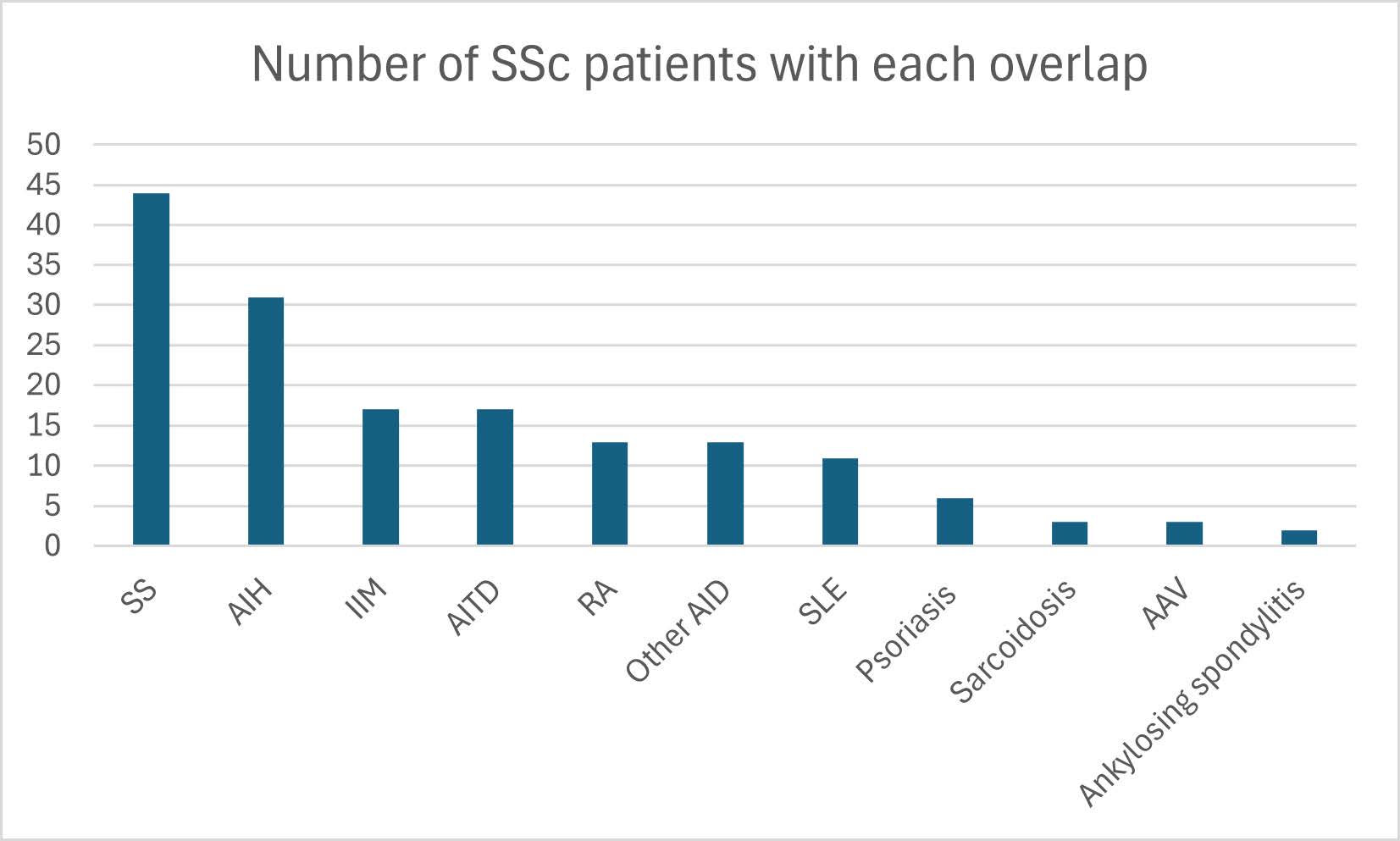Session Information
Session Type: Poster Session B
Session Time: 10:30AM-12:30PM
Background/Purpose: Overt PolyA (the clinical coexistence of ≥2 autoimmune diseases (AID) that fulfill classification criteria), is a frequent phenomenon in systemic sclerosis (SSc). However, the implications of the overlap of SSc with at least another AID in the same patient is not well studied. The purpose of this study is to describe the prevalence and characteristics of the patients presenting overt polyA in a SSc cohort, and to compare their characteristics with those with single SSc as their only AID.
Methods: Ambispective study performed in 3 tertiary Spanish hospitals. Patients diagnosed with any subtype of SSc were included. Extensive demographic, clinical and serological data, and PROs were collected, as well as diagnosis of other AID, that included: rheumatoid arthritis, systemic lupus erythematosus (SLE), Sjögren’s syndrome (SS), idiopathic inflammatory myopathies (IIM), AI thyroid disease (AITD), psoriasis, sarcoidosis, ANCA-vasculitis (AAV), ankylosing spondylitis, AI hepatic diseases and other.
The statistical analysis to study associations was performed using non-parametric tests. The odds ratios (OR) and their confidence intervals (CI) were computed using the unconditional maximum likelihood estimation.
Results: Fifty-one percent of the 313 patients presented overt polyA with SSc, 23 (7.3%) presented 3 concomitant AID, and 2 (0.006%), 4, being SS the most frequent. Table 1 shows the differences between patients with any overt polyA vs not, finding that several autoantibodies (abs) were remarkably associated with higher odds of presenting an overlap, particularly U1RNP both in isolation (OR 11.4; 95% CI 3.4-54.1, p < 0.001) and in combination with ACA (ACA-U1RNP, (OR 11.9; 95% CI 1.4-565.8, p < 0.001).
Table 2 depicts the characteristics associated with having each specific overt overlap, with some of the differences found being expected as derived from the additional AID. Other less common associations were: a higher probability of presenting SLE with some abs [U1RNP (OR 36.7; 95% CI 9.1-159.7, p < 0.001), ACA-U1RNP (OR 21.5; 95% CI 0.6-341.4, p < 0.001), ACA-Ku (OR 14.8; 95% CI 0.4-183.5, p=0.03), ), Ku (OR 10.4; 95% CI 1.3-54.4, p=0.03), and PM/Scl (OR 5.9; 95% CI 1.1-22.9, p=0.03); women had a lower probability of IIM (OR 0.2; 95% CI 0.07-0.6, p=0.005) and AAV (OR 0.06; 95% CI 0.002-0.8, p=0.03); having lSSc vs dSSc (OR 0.2; 95% CI 0.1-0.7, p=0.005) and ACA (OR 0.2; 95% CI 0.02-0.6, p=0.005) were protective factors for IIM while some overlaps of abs increased IIM probability (ACA-U1RNP,, ACA-PM/Scl and ACA-Th/To with OR significantly ranging from 27 to 16.2). Gastric involvement was associated with sarcoidosis (OR 7; 95% CI 0.8-323.3, p=0.03) and hyperuricemia with a 53.3 times increased probability of AAV (OR 95% CI 4-1751.2, p=0.004). AITD was associated with ACA (OR 12.3; 95% CI 4.2-54.5, p < 0.001) and limited SSc (OR 4.1 vs diffuse SSc; 95% CI 1.1-30.1, p=0.03) and, inversely, with pulmonary manifestations (OR 0.3; 95% CI 0.1-0.7, p=0.008).
Conclusion: Apart from some already well-described characteristics, we have found additional data that could warn clinicians about a higher probability of SSc patients presenting overt polyA and, consequently, could help in guiding diagnosis and management.
To cite this abstract in AMA style:
Carrión-Barberà I, Tío L, Triginer L, Lee M, Guillén-del Castillo A, Ribes A, Valencia Muntalà L, Monfort J, Salman Monte: T, Simeón-Aznar C, Pros A, Narvaez-García J. Overt Polyautoimmunity and Its Risk Factors in a Multicenter Cohort of Systemic Sclerosis Patients [abstract]. Arthritis Rheumatol. 2024; 76 (suppl 9). https://acrabstracts.org/abstract/overt-polyautoimmunity-and-its-risk-factors-in-a-multicenter-cohort-of-systemic-sclerosis-patients/. Accessed .« Back to ACR Convergence 2024
ACR Meeting Abstracts - https://acrabstracts.org/abstract/overt-polyautoimmunity-and-its-risk-factors-in-a-multicenter-cohort-of-systemic-sclerosis-patients/



